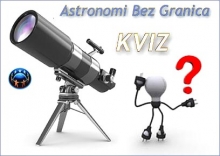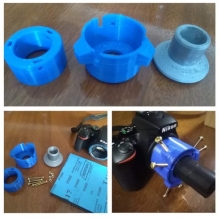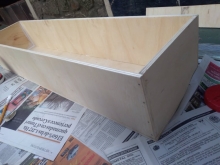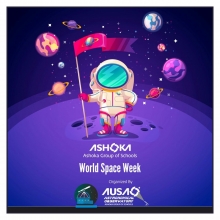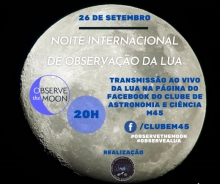By Connie Walker
Sometimes what we lose can be just as important as what we gain. The loss of something that has influenced our culture for millennia can change our culture's perspective of the world around us. Yet if change happens slowly, we may not realize we have lost anything. Case in point: what if a starry night sky had never inspired Van Gogh to paint "Starry Night" or Holst to compose "The Planets" or Shakespeare write sonnets that encompass so much astronomy.
Citizen-science is a rewardingly inclusive way to bring awareness to the public on important issues like the disappearing starry night sky, its cause and solutions. Citizen-science can also provide meaningful, hands-on, minds-on "science process" experiences for the general public and students in particular. One such program that does both is Globe at Night, an international campaign to raise public awareness of the impact of light pollution by having people measure night-sky brightness and submit observations from a computer or smart phone. Students can use the data to monitor levels of light pollution around the world, as well as understand light pollution’s effects on energy consumption, plants, wildlife, human health and our ability to enjoy a starry night sky. Projects have compared Globe at Night data with ground-truthing using meters for an energy audit as well as with data on birds, population density, satellite data and trends over time.
Public involvement in research experiences like these make the point that we have to be better stewards today and teach our children to be better stewards for tomorrow. We have to learn to light more responsibly and that the solutions are simple and feasible. To make these opportunities for research happen in the next few years, more Globe at Night data is needed. Recently through Global Astronomy Month, a call-to-action was made to submit measurements for places that had only one or none in the last five years. This call-to-action is continuing throughout the year.
Globe at Night is every month for 10-days a month in 2014 and 2015. The campaign started as once a year for 10-days a campaign and ran that way until three years ago when we held the campaign twice in 2011, four times in 2012 and five times in 2013. Altogether, participants have measured over 130,000 vetted data points from 115 different countries. A couple of papers have been written in the last year verify the database's validity for use in scientific research.(1,2,3) Also, very importantly, the Globe at Night citizen science campaign collaborates with two apps that also collect night sky brightness data, by folding their data nightly into the Globe at Night database. Those apps are the Loss of the Night app which is now available for both Android and iOS devices and the Dark Sky Meter app which is free during IYL2015.
To entice the public to further participate in Globe at Night during International Year of Light (IYL2015) “Cosmic Light” thematic cornerstone and beyond, each month we target an area of the world we know habitually contributes during that time. Special concerns for how light pollution affects that area and solutions will be featured on the Globe at Night Facebook page, in its electronic newsletter, or in the 365DaysofAstronomy.org podcasts we do. We had an “International Night of Sky Glow Observations” event on PI-Day in mid-March and will conduct another one on Sept 12, where the public is invited to take night sky brightness measurements en mass. As part of the IYL2015 Quality Lighting Teaching Kit, we are planning to hold a contest that involves taking Globe at Night data – a City of Lights contest for the city with the most measurements. Stay tuned for more information on that…
Two other Dark Skies Awareness programs under Global Astronomy Month each year that inspire participation in light pollution citizen-science campaigns like Globe at Night are the International Dark-Sky Week, hosted by the International Dark-Sky Association, and the International Earth and Sky photo contest, hosted with The World at Night. Winners for the photo contest should be announced sometime in May and are worth paying attention to. The expression “a picture is worth a thousand words” never rang truer. May your skies be as exquisite.
Bibliography
1.Kyba, C.C.M.; Tong, K.P.; Bennie, J.; Birriel, I.; Birriel, J.J.; Cool, A.; Danielsen, A.; Davies, T.W.; Outer, P.N. den; Edwards, W.; Ehlert, R.; Falchi, F.; Fischer, J.; Giacomelli, A.; Giubbilini, F.; Haaima, M.; Hesse, C.; Heygster, G.; Hölker, F.; Inger, R.; Jensen, L.J.; Kuechly, H.U.; Kuehn, J.; Langill, P.; Lolkema, D.E.; Nagy, M.; Nievas, M.; Ochi, N.; Popow, E.; Posch, T.; Puschnig, J.; Ruhtz, T.; Schmidt, W.; Schwarz, R.; Schwope, A.; Spoelstra, H.; Tekatch, A.; Trueblood, M.; Walker, C.E.; Weber, M.; Welch, D.L.; Zamorano, J.; Gaston, K.J. (2015) Worldwide Variations in Artificial Skyglow. Scientific Reports 5: 8409.
2.Birriel JJ, Walker CE, Thornsberry CR (2014) Analysis of Seven Years of Globe at Night Data. Journal of the American Association of Variable Star Observers, 42: 219
3.Kyba CCM, Wagner JM, Kuechly HU, Walker CE, Elvidge CD, Falchi F, Ruhtz R, Fischer J, Hölker F (2013) Citizen Science Provides Valuable Data for Monitoring Global Night Sky Luminance. Scientific Reports 3: 1835
 Connie Walker is an Associate Scientist at the National Optical Astronomy Observatory (NOAO) in Tucson, Arizona, USA. For the past 14 years at NOAO, she has enjoyed managing several education outreach programs for the public, students and teachers on hands-on general astronomy, dark skies preservation, optics and solar research. A highlight of her job is directing the popular international light pollution citizen-science campaign, Globe at Night (www.globeatnight.org). To help make a difference, she is president of the Astronomical Society of the Pacific, VP of the International Astronomical Union’s commission on light pollution, on the board of directors of the International Dark-Sky Association (IDA), and oversees the Dark Skies Awareness programs for Global Astronomy Month. For her efforts in bringing dark skies awareness to the public, the IDA awarded her their Hoag-Robinson award. Her amazing astronomer-husband, daughter (20), son (16) and cat (8) thankfully tolerate her interest in the dark side of astronomy.
Connie Walker is an Associate Scientist at the National Optical Astronomy Observatory (NOAO) in Tucson, Arizona, USA. For the past 14 years at NOAO, she has enjoyed managing several education outreach programs for the public, students and teachers on hands-on general astronomy, dark skies preservation, optics and solar research. A highlight of her job is directing the popular international light pollution citizen-science campaign, Globe at Night (www.globeatnight.org). To help make a difference, she is president of the Astronomical Society of the Pacific, VP of the International Astronomical Union’s commission on light pollution, on the board of directors of the International Dark-Sky Association (IDA), and oversees the Dark Skies Awareness programs for Global Astronomy Month. For her efforts in bringing dark skies awareness to the public, the IDA awarded her their Hoag-Robinson award. Her amazing astronomer-husband, daughter (20), son (16) and cat (8) thankfully tolerate her interest in the dark side of astronomy.









